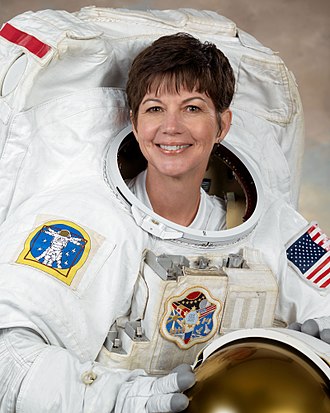|
|
||
|
Pro Tools
FILMFESTIVALS | 24/7 world wide coverageWelcome ! Enjoy the best of both worlds: Film & Festival News, exploring the best of the film festivals community. Launched in 1995, relentlessly connecting films to festivals, documenting and promoting festivals worldwide. Working on an upgrade soon. For collaboration, editorial contributions, or publicity, please send us an email here. User login |
Zero Gravity Doc: Video Introduction by Astronaut Cady Coleman
Catherine Grace "Cady" Coleman (born 14 December 1960) is an American chemist, a former United States Air Force colonel, and a retired NASA astronaut. She is a veteran of two Space Shuttle missions, and departed the International Space Station on 23 May 2011, as a crew member of Expedition 27 after logging 159 days in space.
Coleman graduated from Wilbert Tucker Woodson High School, Fairfax, Virginia, in 1978;[1] in 1978–1979, she was an exchange student at Røyken Upper Secondary School in Norway with the AFS Intercultural Programs. She received a B.S. degree in chemistry from the Massachusetts Institute of Technology (MIT) in 1983 and was commissioned as graduate of the Air Force Reserve Officer Training Corps (Air Force ROTC).,[2] then received a Ph.D. degree in polymer science and engineering from the University of Massachusetts Amherst in 1991.[3][1] She was advised by Professor Thomas J. McCarthy on her doctorate.[4][5] As an undergraduate, she was a member of the intercollegiate rowing crew and was a resident of Baker House.[6] Military career[edit]Coleman continued to pursue her PhD at the University of Massachusetts Amherst as a Second lieutenant. In 1988, she entered active duty at Wright-Patterson Air Force Base as a research chemist. During her work, she participated as a surface analysis consultant on the NASA Long Duration Exposure Facility experiment. In 1991, she received her doctorate in polymer science and engineering.[1] She retired from the Air Force in November 2009 as a colonel.[1] NASA career[edit]
Coleman was selected by NASA in 1992 to join the NASA Astronaut Corps. In 1995, she was a member of the STS-73 crew on the scientific mission USML-2 with experiments including biotechnology, combustion science, and the physics of fluids. During the flight, she reported to Houston Mission Control that she had spotted an Unidentified flying object (UFO). She also trained for the mission STS-83 to be the backup for Donald A. Thomas; however, as he recovered on time, she did not fly that mission. STS-93 was Coleman's second space flight in 1999. She was mission specialist in charge of deploying the Chandra X-ray Observatory and its Inertial Upper Stage out of the shuttle's cargo bay.[1] Coleman served as Chief of Robotics for the Astronaut Office, to include robotic arm operations and training for all Space Shuttle and International Space Station missions.[7] In October 2004, Coleman served as an aquanaut during the NEEMO 7 mission aboard the Aquarius underwater laboratory, living and working underwater for eleven days.[8][9] Coleman was assigned as a backup U.S. crew member for Expeditions 19, 20 and 21 and served as a backup crew member for Expeditions 24 and 25 as part of her training for Expedition 26. Coleman launched on 15 December 2010 (16 December 2010 Baikonur time), aboard Soyuz TMA-20 to join the Expedition 26 mission aboard the International Space Station.[10] She retired from NASA on 1 December 2016. Spaceflight experience[edit]STS-73 on Space Shuttle Columbia (20 October to 5 November 1995) was the second United States Microgravity Laboratory (USML-2) mission. The mission focused on materials science, biotechnology, combustion science, the physics of fluids, and numerous scientific experiments housed in the pressurized Spacelab module. In completing her first space flight, Coleman orbited the Earth 256 times, traveled over 6 million miles, and logged a total of 15 days, 21 hours, 52 minutes and 21 seconds in space. STS-93 on Columbia (22 to 27 July 1999) was a five-day mission during which Coleman was the lead mission specialist for the deployment of the Chandra X-ray Observatory. Designed to conduct comprehensive studies of the universe, the telescope will enable scientists to study exotic phenomena such as exploding stars, quasars, and black holes. Mission duration was 118 hours and 50 minutes. Soyuz TMA-20 / Expedition 26/27 (15 December 2010 to 23 May 2011) was an extended duration mission to the International Space Station.[11] 01.04.2021 | Zero Gravity's blog Cat. : PEOPLE
|
LinksThe Bulletin Board > The Bulletin Board Blog Following News Interview with IFTA Chairman (AFM)
Interview with Cannes Marche du Film Director
Filmfestivals.com dailies live coverage from > Live from India
Useful links for the indies: > Big files transfer
+ SUBSCRIBE to the weekly Newsletter Deals+ Special offers and discounts from filmfestivals.com Selected fun offers
> Bonus Casino
User imagesAbout Zero GravityThe EditorUser contributions |


























 VERRETTE Thomas
VERRETTE Thomas 


